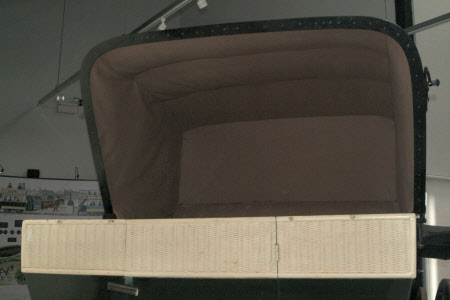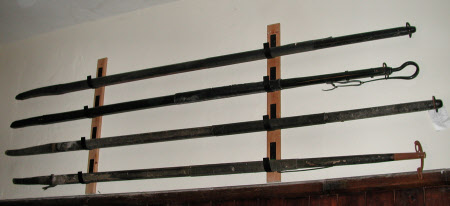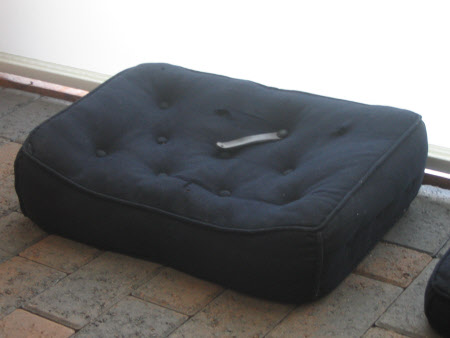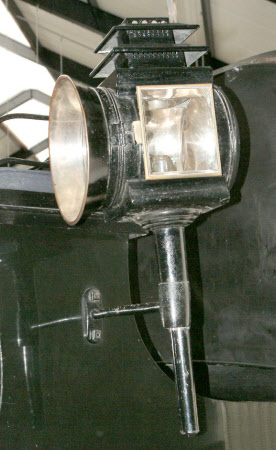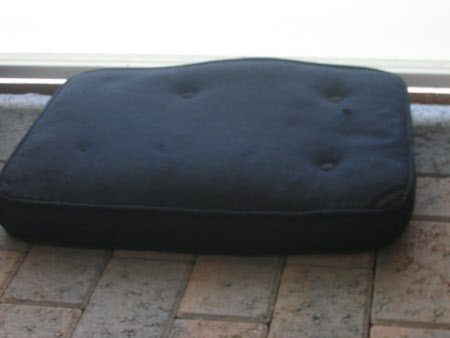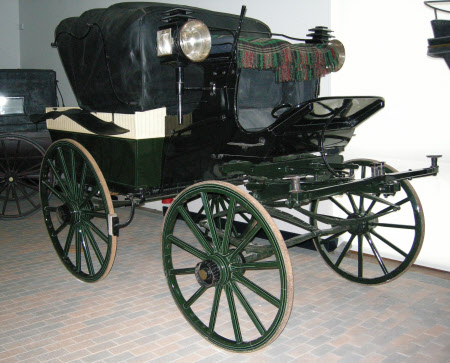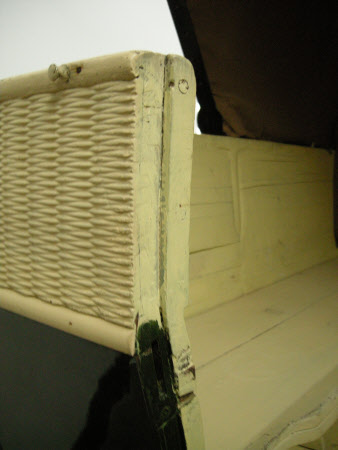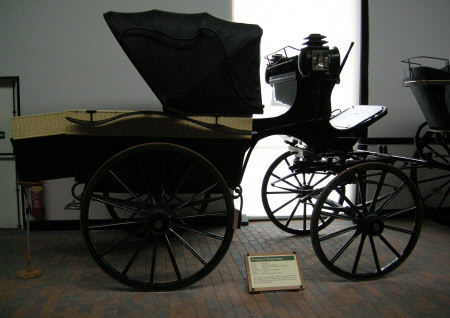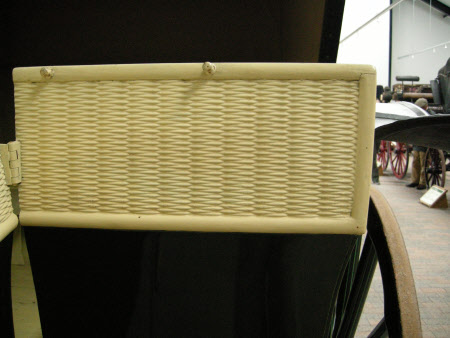Portland wagonette
Silk and Co.
Category
Carriages & other vehicles
Date
1895 - 1910
Materials
Glass, Leather, Linoleum, Metal, Textile, Wood
Measurements
2440 x 2140 mm; 3500 mm (Length)611 kg (Wt)
Place of origin
London
Order this imageCollection
National Trust Carriage Museum
NT 272885
Summary
Portland Wagonette built by Silk and Co. London circa 1900.
Full description
The deep body has slightly concave, flared sides with vertical panels of “waved wood” (mock basketwork) at the top, and a shallow foot well.The seats in the body can be easily lifted out so that it can be used to transport luggage. The seat back across the front of the body implies that a seat board could also be fitted there, and the studs on the outside of the top rail imply that an apron or similar cover could be fitted to provide further protection for the passengers. With imitation canework on body and box seat. In dark green livery, with light green and black lining. Beige buttoned interior trim and two blue buttoned cushions on box seat. On centre pole and full front elliptic and rear leaf springs. 2 candle lamps have been added. This vehicle was built by Silk & Sons, London, for the Wiston Estate at Steyning, near Brighton. Two or four horses would be driven to it, and wagonettes were one of the few carriage types that were suitable to be driven by either the owner or his professional coachman. The prototype of this vehicle was designed in 1893 by the Duke of Portland who wanted a large carriage to drive to hunt meets, which provided more protection than an open wagonette. He devised a method of fitting a leather head (carriage terminology for hood), which folds down forward in this case on two pairs of curved joints, that lowers forward and stows on the boot neck. The seats, that are not now fitted, could be removed enabling a lot of luggage to be carried when required, making it very useful for station and estate work. With the seats fitted it could carry six passengers in the body, and the driver and one more on the box seat. Since the head provided very limited protection compared to that of a Lonsdale Wagonette, and it also looks much less attractive, it is not surprising that this style did not become fashionable, and this example is probably the only survivor. CJN 17.11.06 BODY The deep body has slightly concave, flared sides with vertical panels of “waved wood” (mock basketwork) at the top, and a shallow foot well.The seats in the body can be easily lifted out so that it can be used to transport luggage. The seat back across the front of the body implies that a seat board could also be fitted there, and the studs on the outside of the top rail imply that an apron or similar cover could be fitted to provide further protection for the passengers.Perhaps it was used with side seats when the head was lowered and with one cross seat when the head was raised.The high coachman’s seat, with twin seat rails, is supported on a boot of curved profile, and the seat board has a wooden valance.The front floor is hinged for access to the shallow boot. There is no heel board and there does not appear to be any provision for one. The footboard has radiused ends. Doors Door on two butt hinges, the lower one extended, with brass T handle. Steps Jagged plate rectangular back step of skeletal design with double folding steps that unfold over it, perhaps added to assist older people to mount.Jags worked on the front outer stock hoops. Oval treads on outer roller bolts and oval jagged plate steps on boot sides. Two slots are cut in the back edge of the offside step for no apparent reason. Bow handles at the ends of the footboard to assist when mounting. Lamps Lamp brackets but the lamps are missing. A very fine pair of large wagonette lamps with two-tier rectangular chimneys and nickel trim have been fitted. Although they are lamps of the correct character for this carriage, they are too big for the sockets and do not belong here. FULLER’S BRISTOL – engraved on candle holder caps. Should they remain here? External furniture Brass. Wheels Twelve and fourteen spoke English pattern wheels with staggered spokes, with flat iron tyres. The nearside front wheel shows evidence of repairs/alterations. The front bead has been removed and clips have been fitted at all felloe joints. Axles Collinge’s patent axles – front compassed up, hind straight, presumably because the underside of the floor is close to the axle. Axle arms with oil groove and two turned grooves. LAWSON & HOLDEN LONDON. Offside front wheel removed 9-11-06 – B240 on all components. Springs Elliptic springs in front, bolted to wheel iron heads and axle flaps. No spring clips are fitted. Side springs on conventional scroll irons behind. Fore Carriage Close futchell fore carriage with straight beds, full wheel plate and no sway bar. There are no wheel iron tails. Straight splinter bar mounted above the futchells. Considering the quality of the ironwork of the fore carriage, with decorative swells, it is surprising to see such plain and simple wooden components with no mouldings and no carvings on the fiddle heads. It is possible that all this timber had to be renewed after an accident, or possibly as a result of worm damage or rot. Pole Not seen. ???? Brakes Rolling bar brakes with composition (? Rubber) brake blocks, and linkage to brake lever with painted brake handle. Brake rack bolted to off side of boot. Paint Boot, fore carriage and hind carriage – black. Body panels and wheels – dark green. Light green fine line around side panels of body. Medium black line and two fine light green lines on wheels only. Fore carriage and springs unlined. Waved wood upper panels and inside of body – cream. Leather The head and wings are grained enamelled leather. The head has an iron valance. Leather sleeves on all roller bolts. Leather discs on outer roller bolts and leather beneath treads. Discs and caps missing from inner roller bolts. Internal Trimming Wedge-shaped coachman’s cushion and thinner parallel groom’s cushion, both covered in dark blue cloth. Seat fall missing. Covering for footboard and floor missing. Welted floor cloth, with black and white stencilled pattern on drab ground on inside of door. Head cloth and shallow-buttoned seatback – fawn cloth.
Makers and roles
Silk and Co., coach builder

